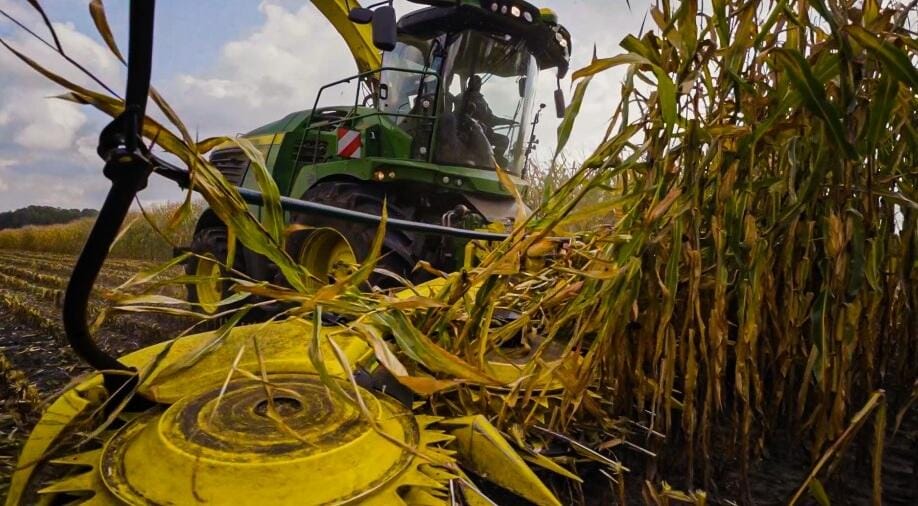At the turn of September and October, the John Deere 9700i self-propelled forage harvester was tested. High productivity of the machine is ensured by its 18-liter engine and HarvestMotion Plus drive.
The 9700i attracted particular interest among livestock farmers who noted such advantages of the forage harvester as high power, ergonomics and ease of operation.
The machine will go on sale in 2023, but four Polish farms have already had the opportunity to learn about its capabilities and present their expectations. From September 28 to October 5, the John Deere team visited two livestock farms and two corn biogas farms to show the 9700i forage harvester with a 9-meter Kemper 490 Plus (on six large chopping drums). What caught the farmers’ attention the most?
Impressive all-terrain mobility and fuel consumption.

Of course, everything depends on the yield, but even at low yields (25 t/ha) the machine achieved a capacity of about 180 t/h. At higher yields (40-45 t/ha) it already reached more than 250 t/h.
On the field where we mowed corn for biogas, so the cut had to be rather short as it was 4 mm and the yield was in the range of 45 t/ha, we got the productivity of 250-260 t/h . During the trials we mowed more than 18 hectares and the diesel consumption was maintained at 28.5 liters per hectare of corn mowed. It was a really good result,”.
says Pavel Kaminsky, John Deere Product Sales Specialist
Behind the 9700i is a new 18-liter six-cylinder engine that requires no Diesel Exhaust Fluid (DEF). Thanks to the exhaust gas cleaning technology used, it meets the latest Stage V European exhaust emission standards, so it can run only on diesel fuel.
In addition, thanks to HarvestMotion PlusTM technology, torque has been significantly increased. More power is produced at lower engine speeds. The effect? The power of the forage harvester is up to 825 hp.
On one farm, we had to deal with weaker corn grown on V-VI class land that yielded 25 tons. In one 10-hour shift we mowed almost 33 hectares at a working speed of 7 by 10. km/h. We got a good result not only in terms of productivity, but also in terms of combustion itself – below 15 l/ha. And in terms of total fuel consumption per ton of mowed weight was 0.59 liters. This is a real result after a day in the field – very competitive in the eyes of farmers,” comments Pavel Kaminsky.
comments Pavel Kaminsky
Farmers who saw the John Deere forage harvester in action and compared it to previous machines said its power and overall ergonomics were amazing. After just one day, it became clear that their field could have much more potential, and thus ultimately yield higher profits.
Cut and forage quality under control

During the demonstrations, very fine grain milling was appreciated.
The 9700i features the JD XStream KPTM core processor with Dura Line XCUT rollers that crush the grain into multiple pieces, but also disturb the structure of the harvested crop. In addition, the mass channel has state-of-the-art Dura Line liners; they are extremely resistant to wear and tear. John Deere gives a warranty on these components for 3,000 engine hours or 5 years of operation,”
explains Pavel Kaminsky.
Most impressive, however, were the HarvestLab 3000 solution and AutoLOC system. The latter allows for automatic adjustment of the cut.
When the mass is drier, it cuts shorter, when the mass is wetter, it cuts to a higher height. The AutoLOC system improves the proper compaction of the silage heap by 20-30 kg per m³. As you know, less air in the pile means more accurate compaction and therefore better material quality for cattle,” explains Pavel Kaminsky.
HarvestLab refers to precision farming solutions already known from other John Deere machines. However, the option to integrate it with the 9700i forage harvester proved to be a hit with farmers. With the HarvestLab 3000 we get a reliable nutrient analysis of the harvested material. The participants of the fall shows, in addition to getting yield maps, also got a chart of the harvested area, which included information on the content of: acid and neutral-detergent fibers (ADF and NDF), starch, sugar, impurities ( so called ash).
One of the breeding farms we visited has about 4,000 head of cattle. As the owner pointed out, with that number of cattle, the intelligent HarvestLab™ 3000 is an invaluable aid in the TMR feeding system. Detailed information on crop quality allows for much better ration planning”,
says Pavel Kaminsky.
What’s more, the HarvestLab sensor is a universal farmer’s convenience.
When the forage harvester is not working, after the season it is enough to dismantle the sensor and connect it to a laptop with the appropriate kit. Thanks to this we can even measure and monitor silage quality every day,”
says Paweł Kaminski.
Comfortable work – efficient work

Last but not least, a feature of the forage harvester, which was noticed by the operators, was the comfortable cab. Good soundproofing and well-thought-out layout were emphasized. Overall comfort was the air-suspended seat, roominess, comfortable touch screens, intuitive menus. All this, in the context of the machine’s technical progress, may be considered a trifle, but in the end it affects the operator’s concentration and alertness during long hours of work.




